Peek Brothers Racing
and
Peek Brothers Race Cars

1968 was another year of refinement and change. The big and dramatic change was bodywork. I don't recall if there was an intent to do all of the bodywork or not. In '67 we still had a stock deck lid, cowl, top of hood and a tonneau cover made of convertible top material. That floppy tonneau had to go and the rest of it probably just had to happen to make the aluminum tonneau work. Since Colorado was not like Southern California as far as a racing industry goes we did not have much if any choice of who to have do the bodywork. Bob Geer was a local one man body shop who was responsible for several dragster bodies. Bob was a bit independent and apparently could afford to take on jobs that he wanted to do and didn't necessarily need to do. I think he owned his building and he certainly only worked on his schedule. I don't remember when we took the car to him, but I do remember that it took several months to get done and I don't think any of the hounding we did helped speed up the process.
Needing something to do, I bought a go cart, a Rathman (Jim Rathman of Indy fame) which was ultra modern aluminum monoque construction with ultra antique scrubber brakes on the rear tires. We put a Mac-6 on it and went out and played on parking lots until we got run off by the owner or the cops.
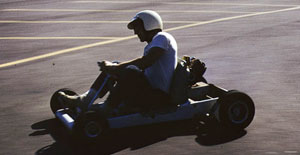
When we finally got the car back there was still work to be done. Obviously the metal finishing and a new paint job with yet another color. The sorry excuse for headers form the year before were replaced with a set of tuned headers that I welded up from a pile of U-bends, straight tubing and preformed collectors. The same task awaits me again in the modern rebuild. The grill shell was filled and chromed.
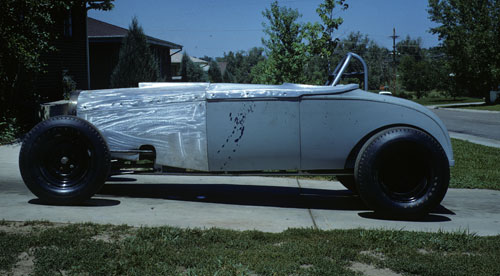
With the aluminum work finished we still had a fair amount of work ahead of us. You can now see the final stance and body lines that would define the car.
Without any wind tunnel testing or filming of yarn we never knew if the top of the tonneau created a spoiler. The coupe body lines are now easily seen. The coupe does not have the long flat area behind the passenger compartment like a roadster body. As I recall the passenger compartment length is about 10" longer inside than a roadster which eliminates flat area, which I like much better. The body line created by the original bead where the top was cut off does kick up nicely and may have had some impact on the air flow. We never thought it would do much good to put a ping pong table in a wind tunnel anyway.
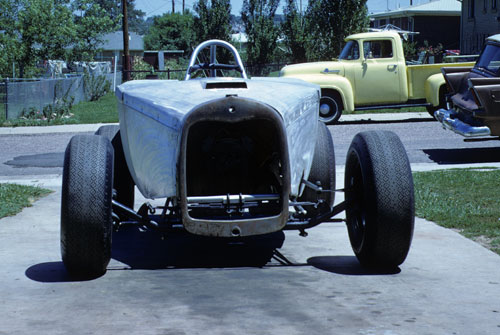
The front view certainly has a different appearance than a standard '29. The smooth sides and top may not do anything to reduce the frontal area but probably does make the air get around a bit better.
For some reason at this time we thought we had an air intake sitting on top of the hood. Since we had a Plymouth Super Stock engine and some experience with the '63 & '64 Plymouth super stockers the shape of the scoop was probably influenced by Detroit. Later we would build an air box on the injectors to seal to the inside of the hood to make sure that all the air that went in the hood would go out the headers. The problem was that almost no air went in the hood. With the air box installed, the engine barely ran, starving for oxygen!
Note the PU in the background, not the ugly duckling any more. How about the back of the '55 or '56 Dodge 2 door station wagon
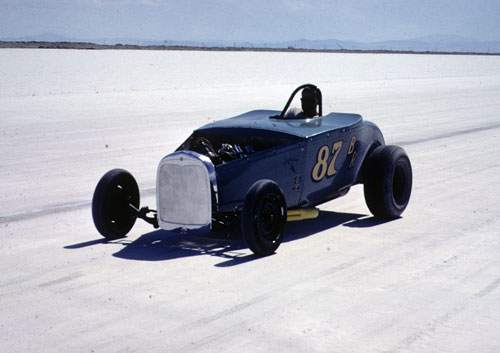
A trip to the warm up area was a common thing. I don't know in reality what was ever accomplished out there other than launching me off the side of the truck one day. I was on the running board when we pushed the car off. It fired and took off and somehow so did I only the truck was going a lot faster than my legs could. I remember making a few strides, then tumbling down, rolling around on the salt and coming back up running. A perfect five point landing, one knee, one elbow, the right hip, and both shoulder blades. I think I still have all the scars. Thanks to the salt, no blood but a trip down to see Doc Gillette to get checked out anyway. He cut my pant legs off which resulted in a sun burn that made me forget about any other pain!
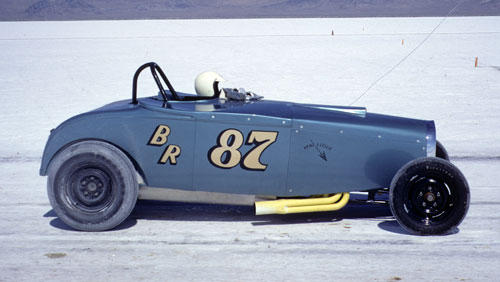
It's starting to look like something, but obviously not there yet. At least we finally got rid of the big fat tires. The fronts are Firestone buffed rib sprint car tires and the rears, genuine Firestone Bonneville 7:60 X 15's thanks to Marv Porter from Parnelli Jones Firestone.
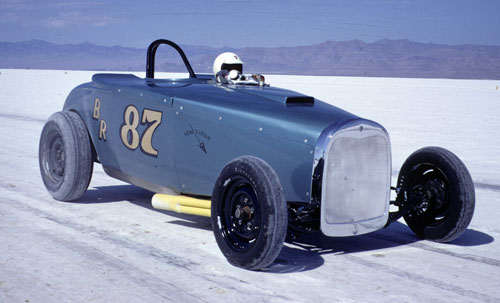
I don't know what happened to the headrest strap that was on the car in '66 and when it came back from getting the aluminum body work done, but it's obviously MIA. I think it is a safe bet that in the days of pre SFI Chassis Spec's there were safety things that were not given any thought. I think it would be easy for a helmet and head to get outside of that cage.
One of my concerns in rebuilding the car for 2012 is that the 6 point cage with appropriate padding will stick up higher and farther forward. Forty five years later safety is a bigger consideration but I must do what I can to maintain the original appearance to the greatest degree possible.
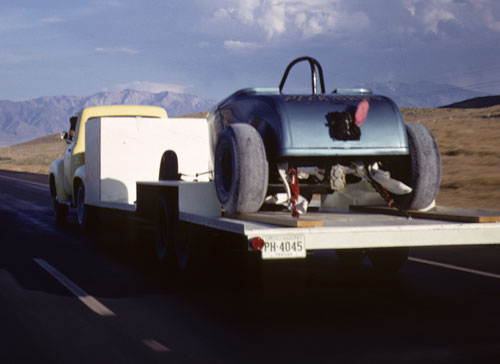
After another year of not going fast, mired in the 170's, we head for home. This year with our own trailer, a trailer house / travel trailer frame which would become an enclosed trailer.
Although the car had come a long way in three short years, it was not done yet and not something Roy Leslie would have been proud of. The following winter, thinking we had a super nice car we entered the roadster in the Sabers car show at the Denver Coliseum In a class of two or three, we came in somewhere below 1st which provided a valuable lesson about detailing which paid off the next year.